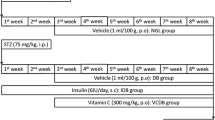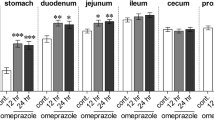Abstract
Gastric pathology is a common complication in diabetes mellitus. The aim of the study was to evaluate the functions and morphological changes of the parietal cells of the rat stomach after streptozotocin-induced diabetes. Diabetes mellitus was induced in Wistar rats by a single intraperitoneal injection of streptozotocin (60 mg/kg body weight). The rats were weighed weekly and sacrificed after 6 months. The glandular portion of the stomach was removed and processed for H+-K+-ATPase immunohistochemistry and light and electron microscopy studies. Acid secretion was measured in vivo. After 6 months of diabetes, the mean weight of the rats was significantly lower (P < 0.001) compared to control. The mean weight of the stomach to body weight percentage increased significantly (P < 0.001) compared to control. The blood glucose level in diabetic rats was significantly higher (P < 0.001) than in normal control. Diabetic rats showed significant (P < 0.001) decrease in basal and stimulated acid secretion when compared to control. Electron micrographs of the parietal cells of glandular stomach of diabetic rats revealed significant (P < 0.0002) reduction in the number of mitochondria and a small though not significant increase in the number of canaliculi in the parietal cells compared with normal. Immunohistochemistry showed reduced H+-K+-ATPase (P < 0.00001) compared to control. Long-term diabetes induces morphological as well as functional changes in gastric parietal cells. The decrease in the number of mitochondria accompanied by reduced in H+-K+-ATPase in parietal cells may explain the reduced acid secretion observed in diabetics.





Similar content being viewed by others
References
Laakso M (2001) Cardiovascular disease in type-2 diabetes: challenge for treatment and prevention. J Int Med 249:225–235
King H, Aubert R, Herman W (1998) Global burden of diabetes, 1995–2025. Prevalence, numerical estimates and projections. Diabetes Care 21:1414–1431
Zimmet P (2000) Globalization, coca-colonization and the chronic disease epidemic: can the doomsday scenario be averted? J Med 247:301–310
Seki M, Tanaka T, Nawa H, Usui T, Fukuchi T, Ikeda K, Abe H, Takei N (2004) Involvement of brain-derived neurotrophic factor in early retinal neuropathy of streptozotocin-induced diabetes in rats: therapeutic potential of brain-derived neurotrophic factors from dopaminergic amacrine cells. Diabetes 53:2412–2419
Huang C, Kim Y, Caramori ML, Fish AJ, Rich SS, Miller ME, Russell GB, Mauer M (2002) Cellular basis of diabetic nephropathy: II. The transforming growth factor-beta system and diabetic nephropathy lesions type 1 diabetes. Diabetes 51:3577–3581
Bearse MA Jr, Han T, Schneck ME, Barez S, Jacobsen C, Adams AJ (2004) Local multifocal oscillatory potential abnormalities in diabetes and early diabetic retinopathy. Invest Ophthal Vis Sci 45:3259–3265
Svensson M, Eriksson JW, Dahlquist G (2004) Early glycemic control, age at onset, and development of microvascular complication in childhood-onset type 1 diabetes: a population-based study in Northern Sweden. Diabetes Care 27:955–962
Wallace C, Reiber GE, LeMaster J, Smith DG, Sullivan K, Hayes S, Vath C (2002) Incidence of falls, risk factors for falls, and fall-related fractures in individuals with diabetes, and a prior foot ulcer. Diabetes Care 25:1983–1986
O’Reilly D, Long RG (1987) Diabetes and the gastrointestinal tract. Dig Dis Sci 5:57–64
Takehara K, Tashima K, Takeuchi K (1997) Alterations in duodenal bicarbonate secretion and mucosal susceptibility to acid in diabetic rats. Gastroenterology 112:418–428
Lin CY, Yeh GH, Hsu FC, Tsai SC, Lau CP, Pu HF, Yu HL, Tung YF, Wang PS (1991) Gastric acid secretion in streptozotocin-diabetic female rats. Clin J Physiol 34:179–186
Baydoun R, Dunbar JC (1997) Impaired insulin but normal pentagastrin effect on gastric acid secretion in diabetic rats: a role for nitric oxide. Diabetes Res Clin Pract 38:1–8
Forte JG, Hanzel DK, Urushidani T (1989) Mechanism of parietal cell function. In: Garner A, Whittle BJR (eds) Advances in drug therapy of gastrointestinal ulceration. Wiley, New York, pp 33–52
Rabon E, Reuben MA (1990) Conformational transitions of the H, K-ATPase studied with sodium ions as surrogates for protons. Annu Rev Physiol 52:321–334
Besancon M, Simon A, Sachs G, Shin KM (1997) Sites of reaction of the gastric H, K-ATPase with extracellular thiol reagents. J Biol Chem 272(36):22438–22446
Feldman M, Schiller LR (1983) Disorders of gastrointestinal motility associated with diabetes mellitus. Ann Intern Med 98:378–384
Tashima K, Nishijima M, Fujita A, Kawauchi S, Takeuchi K (2000) Gastric acid secretion in streptozotocin-diabetic rats—different responses to various secretagogues. J Physiol (Paris) 94:11–17
Chang FY, Chen TS, Lee SD, Doong ML, Yeh GH, Wang PS (2004) Pentagastrin-induced gastric acid secretion in the diabetic rats: role of insulin. Chin J Physiol 47:175–181
Korolkiewicz RP, Tashima K, Fujita A, Kato S, Takeuchi K (2000) Exogenous insulin-like growth factor (IGF)-1 improves the impaired healing of gastric mucosal lesions in diabetic rats. Pharmacol Res 41:221–229
Obineche EN, Adeghate E, Chandranath IS, Benedict S, Al Gafri LS, Adem A (2004) Alterations in atrial natriuretic peptide and its receptors in streptozotocin-induced diabetic rat kidney. Mol Cell Biochem 261:3–8
McDowell EM, Trump BF (1976) Histologic fixatives suitable for diagnostic light and electron microscopy. Arch Pathol Lab Med 100(8):405–414
Bastaki SMA, Chandranath SI, Singh J (2002) Comparison of antisecretory and antiulcer activity of epidermal growth factor, urogastrone and transforming growth factor alpha and its derivative in rodents in vivo. Mol Cell Biochem 236:83–94
Karnovsky MJ (1965) A formaldehyde-glutaraldehyde fixative of high osmolarity for use in electron microscopy. J Cell Biol 27:137–138
Reynolds ES (1963) The use of lead citrate at high pH as an electron-opaque stain in electron microscopy. J Cell Biol 17:208–212
Weber JR, Ryan JC (1998) Effects on the gut of systemic disease and other extraintestinal conditions. In: Scharschmidt BF, Sleisinger MH, Feldman M (eds) Gastrointestinal and liver disease. WB Saunders Co, Philadelphia, pp 413–416
Obineche EN, Mensah-Brown E, Chandranath SI, Ahmed I, Naseer O, Adem A (2001) Morphological changes in the rat kidney following long-term diabetes. Arch Physiol Biochem 109(3):241–245
Feldman M, Corbett DD, Ramsey EJ, Walsh JH, Richardson CT (1979) Abnormal gastric function in longstanding, insulin-dependent diabetic patients. Gastroenterology 77:12–17
Nakamura T, Imamura K, Abe Y, Yoneda M, Watahiki Y, Makino I, Takebe K, Kikuchi H (1986) Gastric functions in diabetics: gastrin responses and gastric acid secretion in insulin-induced hypoglycaemia. J Jpn Diabetes Soc 29:3–8
Colin-Jones DG, Himsworth RL (1970) The location of chemoreceptors controlling gastric acid secretion during hypoglycaemia. J Physiol 206:397–409
Kovacs TOG, Lloyd KCK, Walsh JH (1996) Gastrin partially mediates insulin-induced acid secretion in dogs. Peptides 17(4):583–587
Hersey SJ, Sachs G (1995) Gastric acid secretion. Physiol Rev 75:155–189
Angervall L, Dotevall G, Lehmann KE (1961) The gastric mucosa in diabetes mellitus. A functional and histopathological study. Acta Med Scand 169:339
Miller ML, Judd LM, van Driel IR, Andringa A, Flagella M, Bell SM, Schultheis PJ, Spicer Z, Shull GE (2002) The unique ultrastructure of secretory membranes in gastric parietal cells depends upon the presence of H+, K+-ATPase. Cell Tissue Res 309:369–380
Karunanayake EH, Hearse DJ, Mellows G (1976) Streptozotocin: its excretion and metabolism in the rat. Diabetologia 12:483–488
Shoji E, Okumura T, Kohgo Y (1996) Intraduodenal lipid does not inhibit acid secretion in OLETF rats not expressing CCK-A receptor gene. Dig Dis Sci 41:2174–2179
Riley WJ, Toskes PP, Maclaren NK, Silverstein JH (1982) Predictive value of gastric parietal cell autoantibodies as a marker for gastric and hematologic abnormalities associated with insulin-dependent diabetes. Diabetes 31:1051–1055
De Block CEM, De Leeuw IH, Van Gaal LF (1999) High prevalence of manifestations of gastric autoimmunity in parietal cell antibody-positive type-1 (insulin-dependent) diabetic patients, The Belgian Diabetic registry. J Clin Endocrinol Metab 84:4062–4067
De Block CEM, De Leeuw IH, Rooman RPA, Winnock F, Du Caju MVL, Van Gaal LF, the Belgian Diabetic Registry (2000) Gastric parietal cell antibodies are associated with glutamic acid decarboxylase-65 antibodies and the HLA DQA1*0501-DQB1*0301 haplotype in type 1 diabetes. Diabetic Med 17:618–622
Karlsson FA, Burman P, Lööf L, Olsson M, Scheynius A, Mardh S (1987) Enzyme-linked immunosorbent assay of H+/K+-ATPase, the parietal cell antigen. Clin Exp Immunol 70:604–610
Toh BH, Sentry JW, Alderuccio F (2000) The causative H+/K+-ATPase antigen in the pathogenesis of autoimmune gastritis. Immunol Today 21:348–354
Karam SM, Forte JG (1994) Inhibiting gastric H(+)-K(+)-ATPase activity by omeprazole promotes degeneration and production of parietal cells. Am J Physiol 266:G745–G758
Kakei N, Ichinose M, Tatematsu M, Shimizu M, Oka M, Yahagi N, Matsushima M, Kurokawa K, Yonezawa S, Furihata C, Shiokawa K, Kageyama T, Miki K, Fukamachi H (1995) Effects of long-term omeprazole treatment on adult rat gastric mucosa—enhancement of the epithelial cell proliferation and suppression of its differentiation. Biochem Biophys Res Commun 214:861–868
Hunt JV, Dean TR, Wolff SP (1988) Hydroxy radical production and autooxidative glycosylation: glucose autooxidation as the cause of protein damage in the experimental glycation model of diabetes mellitus and aging. Biochem J 256:205–212
Desco MC, Asensi M, Marquez R, Martinez-Valls J, Vento M, Pollardo FV, Sastre J, Viňa J (2002) Xanthine oxidase is involved in free radical production in type 1 diabetes: protection by allopurinol. Diabetes 51:118–124
Baynes J (1991) Role of oxidative stress in development of complications in diabetes. Diabetes 40:405–412
Vincent AM, Brownlee M, Russell JW (2002) Oxidative stress and programmed cell death in diabetic neuropathy. Ann N Y Acad Sci 959:368–383
Author information
Authors and Affiliations
Corresponding author
Rights and permissions
About this article
Cite this article
Bastaki, S.M.A., Adeghate, E., Chandranath, I.S. et al. Effects of streptozotocin-induced long-term diabetes on parietal cell function and morphology in rats. Mol Cell Biochem 341, 43–50 (2010). https://doi.org/10.1007/s11010-010-0435-4
Received:
Accepted:
Published:
Issue Date:
DOI: https://doi.org/10.1007/s11010-010-0435-4




